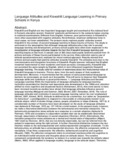| dc.description.abstract | Kiswahili and English are two important languages taught and examined at the national level in Kenya's education system. Students' academic performance in the subjects keeps varying in national examinations. Different from English, however, poor performance in Kiswahili is more often associated with negative attitudes. Nevertheless, empirical validations have in most cases, not been established. The present study explores pupils' attitudes toward Kiswahili in the context of second language learning in Siaya County of Kenya. The study is anchored on the assumption that although language attitudes play a big role in second language learning and development, primary school pupils have often been neglected in the investigation of language attitudes despite the fact that Kiswahili language learning and teaching begins at that level. A sample size of 360 class eight pupils randomly picked from 18 primary schools of Siaya County participated in the survey. Data collection was by use of attitude questionnaires and, analysed by mixed method approach. Results showed that primary school pupils had positive attitudes towards Kiswahili. The attitudes were due to the communicative and integrative functions of Kiswahili. Pupils however indicated that English remained instrumental to their academic and future pursuits. Consequently, Kiswahili was not accorded the same weight as English, which in turn influenced negatively Kiswahili language learning. The study calls for creation of awareness about the instrumental value of Kiswahili language to learners. This be done, from the early stages of their academic development. Moreover, it recommends that the culture of using grammatical language by learners be encouraged, as much as it is possible. This will serve to improve their Kiswahili language skills and contribute to good performance. 1. Language Attitudes and Second Language Learning While the importance of language attitudes for language learning motivation postulated by Gardner and associates was downplayed in the 1990s and, attention shifted to more cognitive and situational factors (Heinzmann, 2013), this trend seems to have been reversed recently as studies have shown that language attitudes influence second language learning (Masgoret and Gardner, 2002; Brown, 2007; Simandan, 2016). The role of language attitudes and motivation in second language learning cannot be over emphasized (Brown, 2007, Ahmed, 2015). Attitude is defined not as a behaviour, but rather as "preparation for behaviour", a predisposition to respond in a favourable or unfavourable manner to an attitude object, which includes things, places, people, situations or ideas (Oskamp, 1977:8). A considerable number of theories have been developed on the study of language attitudes (see Agheyisi & Fishman, 1970, pp. 137-149 for a brief review). In the present study, however, we make a theoretical distinction between the behaviourist and mentalist viewpoints. The behaviourist perspective views attitude as a response to a certain situation (Agheyisi & Fishman, 1970) and considers it a dependent variable that can be statistically determined through observation of behaviour in social situations (Cherciov, 2012). Alternatively, the mentalist perspective views attitudes as a mental and neutral state of disposition (Allport, 1967 cited by Cherciov, 2012), that are not directly observable, but can be inferred from the subject's responses using the right stimuli. A further theoretical distinction between the two theories relates to the unicomponential and multicomponential conception of attitude. To the behaviourists, an attitude has a unicomponential structure, the affective component, while to mentalists, it has three components: the affective, behavioural (conative) and cognitive (Bouzidi, 1986). The affective component refers to emotional reactions while the cognitive to an individual's belief structure and thoughts about an attitude object. The conative component comprehends the tendency to behave in a certain way towards the attitude object (Baker, 1992). When applied to language studies, language is the attitude object. Therefore, language attitudes are, according to Baker (1992) the feelings people have about their own language or language(s) of others. | en_US |

